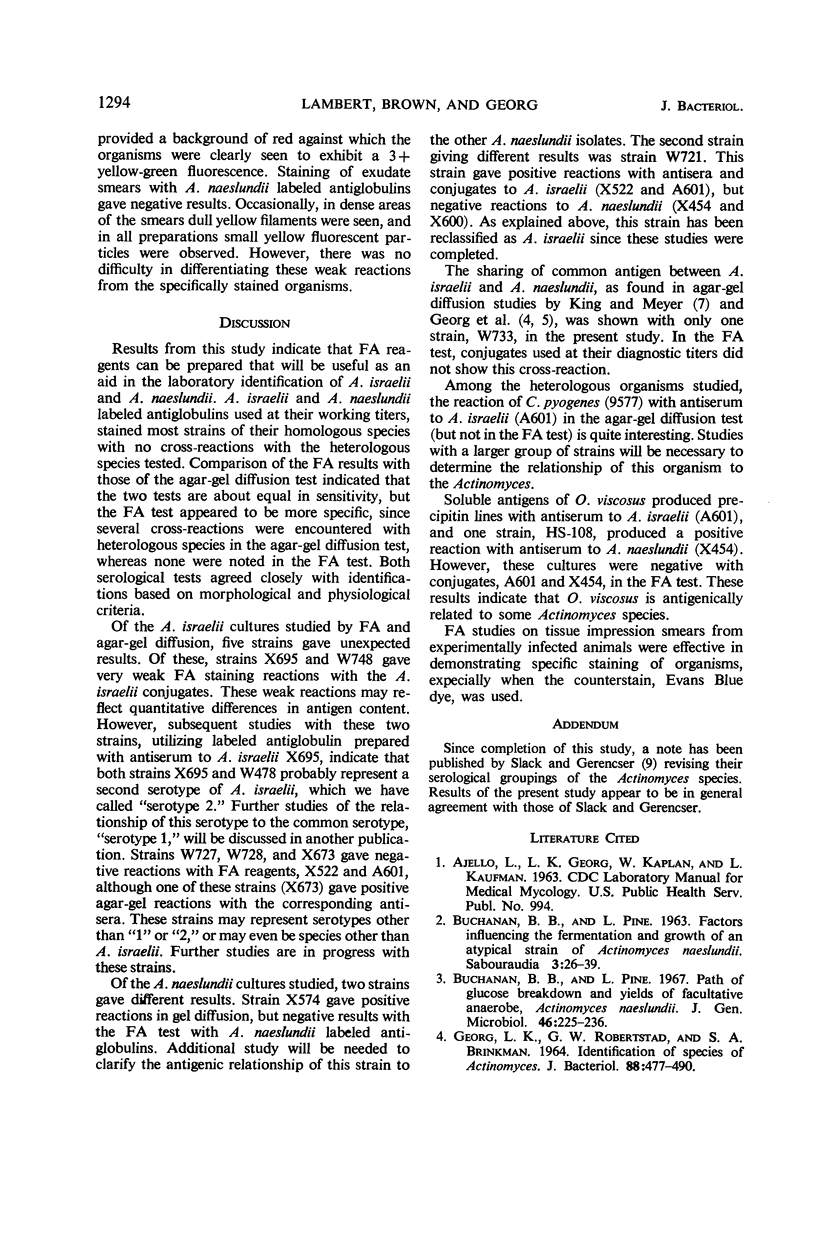Abstract
This study was an attempt to develop a fluorescent-antibody (FA) test to differentiate Actinomyces israelii and A. naeslundii as an aid in their laboratory identification. Two strains of A. israelii (X522 and A601) and two strains of A. naeslundii (X454 and X600), which had received intensive study by several investigators, were used for the immunization of rabbits. Working titers, based on tests with antigens prepared from the homologous strains and from well-established heterologous strains, were determined for each labeled antibody preparation. These conjugates and their normal serum control conjugates were used separately to stain 85 cultures of Actinomyes species and 23 strains of other species that might be confused with them. Acetone-precipitated soluble antigens from these same strains were tested with different antisera in the agar-gel diffusion test. Results showed that A. israelii (X522 and A601) and A. naeslundii (X454 and X600) labeled antiglobulins, when used at their working titers, stained most strains of their homologous species. Agar-gel diffusion results showed general agreement with those of the FA tests. The two tests appear to be equal in sensitivity, but the FA test is more specific, since several cross-reactions were noted with the agar-gel diffusion test whereas no cross-reactions were obtained with the FA reagents. Agar-gel and FA studies suggest that at least two serotypes of A. israelii may be associated with human disease. Although the majority of strains tested in this study appear to belong to a common serotype, “serotype 1,” two strains of an apparent second serotype, “serotype 2,” were encountered. FA staining of tissue impression smears from experimentally infected mice was successful when a counterstain, Evans Blue dye, was used.
Full text
PDF








Selected References
These references are in PubMed. This may not be the complete list of references from this article.
- Buchanan B. B., Pine L. Factors influencing the fermentation and growth of an atypical strain of Actinomyces naeslundii. Sabouraudia. 1963 Oct;3(1):26–39. doi: 10.1080/00362176485190071. [DOI] [PubMed] [Google Scholar]
- Buchanan B. B., Pine L. Path of glucose breakdown and cell yields of a facultative anaerobe, Actinomyces naeslundii. J Gen Microbiol. 1967 Feb;46(2):225–236. doi: 10.1099/00221287-46-2-225. [DOI] [PubMed] [Google Scholar]
- GEORG L. K., ROBERTSTAD G. W., BRINKMAN S. A., HICKLIN M. D. A NEW PATHOGENIC ANAEROBIC ACTINOYCES SPECIES. J Infect Dis. 1965 Feb;115:88–99. doi: 10.1093/infdis/115.1.88. [DOI] [PubMed] [Google Scholar]
- GEORG L. K., ROBERTSTAD G. W., BRINKMAN S. A. IDENTIFICATION OF SPECIES OF ACTINOMYCES. J Bacteriol. 1964 Aug;88:477–490. doi: 10.1128/jb.88.2.477-490.1964. [DOI] [PMC free article] [PubMed] [Google Scholar]
- HOWELL A., Jr, MURPHY W. C., 3rd, PAUL F., STEPHAN R. M. Oral strains of Actinomyces. J Bacteriol. 1959 Jul;78(1):82–95. doi: 10.1128/jb.78.1.82-95.1959. [DOI] [PMC free article] [PubMed] [Google Scholar]
- KING S., MEYER E. Gel diffusion technique in antigen-antibody reactions of Actinomyces species and "anaerobic diphtheroids". J Bacteriol. 1963 Jan;85:186–190. doi: 10.1128/jb.85.1.186-190.1963. [DOI] [PMC free article] [PubMed] [Google Scholar]
- NICHOLS R. L., McCO MB D. E., HADDAD N., MURRAY E. S. Studies on trachoma. II. Comparison of fluorescent antibody, giemsa, and egg isolation methods for detection of trachoma virus in human conjunctival scrapings. Am J Trop Med Hyg. 1963 Mar;12:223–229. [PubMed] [Google Scholar]
- Slack J. M., Gerencser M. A. Revision of serological grouping of Actinomyces. J Bacteriol. 1966 May;91(5):2107–2107. doi: 10.1128/jb.91.5.2107-.1966. [DOI] [PMC free article] [PubMed] [Google Scholar]
- Slack J. M., Winger A., Moore D. W. SEROLOGICAL GROUPING OF ACTINOMYCES BY MEANS OF FLUORESCENT ANTIBODIES. J Bacteriol. 1961 Jul;82(1):54–65. doi: 10.1128/jb.82.1.54-65.1961. [DOI] [PMC free article] [PubMed] [Google Scholar]
- THOMASON B. M., CHERRY W. B., DAVIS B. R., POMALES-LEBRON A. Rapid presumptive identification of entero-pathogenic Escherichia coli in faecal smears by means of fluorescent antibody. 1. Preparation and testing of reagents. Bull World Health Organ. 1961;25:137–152. [PMC free article] [PubMed] [Google Scholar]


